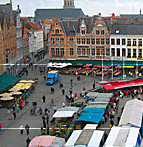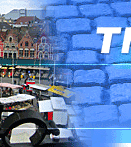A day trip to Bruges offers one of Europe's most rewarding travel experiences, transporting visitors into a perfectly preserved medieval world where cobblestone streets wind between centuries-old buildings and fairy-tale architecture reflects in peaceful canals. With careful planning and insider knowledge, a single day provides sufficient time to experience the highlights of this UNESCO World Heritage city while avoiding the common mistakes that leave many day-trippers feeling rushed and overwhelmed.
The key to a successful Bruges day trip lies in understanding the city's rhythm, starting early to beat the crowds, and focusing on experiences that can only be found in this unique medieval setting. With 27,000 daily visitors and rising tourism numbers, strategic timing and smart route planning transform a potentially stressful experience into magical memories that last a lifetime.
Getting to Bruges: Transportation Options
From Brussels by Train: The most convenient and popular option connects Brussels Central Station to Bruges in exactly one hour, with frequent departures throughout the day making flexibility easy for day trip planning. Belgian national railway (SNCB) operates modern, comfortable trains that provide scenic views of the Flemish countryside while offering reliable, punctual service that eliminates transportation stress.
Trains depart Brussels approximately every hour from early morning until late evening, with the first departure around 6:30 AM and the last return around 11:00 PM. Ticket prices for second-class seats cost approximately €15 each way for adults, with advance online booking offering slight discounts and guaranteed seating during peak periods. First-class upgrades provide more spacious seating and quieter carriages for a modest additional cost.
Bruges train station sits about 1.5 kilometers south of the historic center, connected by regular bus service (lines 1, 4, 6, 11, and 16) that reaches the Markt square in approximately 15 minutes. Many visitors choose to walk this distance, enjoying a pleasant introduction to the city while passing through residential neighborhoods that provide glimpses of local life beyond the tourist center.
From Other Belgian Cities: Direct train connections link Bruges to Ghent (30 minutes), Antwerp (1 hour 15 minutes), and other major Belgian cities, making it easily accessible for travelers staying elsewhere in the country. International visitors can also reach Bruges directly from Amsterdam (3.5 hours) or Paris (4 hours) via high-speed rail connections, though these journeys require advance planning for day trip feasibility.
By Car Considerations: While driving to Bruges provides flexibility in timing and allows for easy exploration of surrounding areas, parking in the historic center presents significant challenges due to limited spaces, high costs (€2-4 per hour), and narrow medieval streets unsuitable for modern vehicle traffic. Several large parking facilities on the city outskirts offer better value and connect to the center via bus or pleasant walks.
Early Morning Arrival Strategy (8:00-10:00 AM)
The Magic of Empty Streets: Arriving in Bruges before 9:00 AM provides the incredible experience of having the medieval city largely to yourself, with empty cobblestone streets, unobstructed photo opportunities, and peaceful canals that reflect morning light without the disturbance of tour groups and crowds. This early timing allows for intimate moments with the architecture and atmosphere that define Bruges' special character.
Early morning light creates optimal conditions for photography, with soft illumination that enhances the warm tones of medieval buildings while avoiding the harsh shadows that develop later in the day. The famous Rozenhoedkaai viewpoint, often crowded by mid-morning, offers unobstructed views of the canal with the Belfry's reflection during these precious early hours.
First Stop: The Markt Square: Begin your exploration at the heart of Bruges, where the magnificent Markt square showcases the city's most iconic architecture in morning tranquility. The towering Belfry dominates the square, while colorful guild houses and the Provincial Court create a stunning ensemble that represents centuries of civic pride and architectural achievement.
Take time to absorb the scale and details of these buildings before the square fills with tour groups, horse-drawn carriages, and vendors setting up for the day. The morning hours allow for contemplation of the historical significance and architectural mastery that earned Bruges its UNESCO designation, creating appreciation that enhances every subsequent experience.
Belfry Timing Strategy: If climbing the Belfry's 366 steps appeals to you, early morning provides the best experience with shorter queues, cooler temperatures, and clearer views before afternoon haze develops. The Belfry opens at 9:00 AM during summer months (10:00 AM in winter), and advance time-slot booking ensures access during your preferred time. The 20-minute climb rewards visitors with panoramic views across Bruges and the surrounding Flemish countryside.
Mid-Morning Exploration (10:00 AM-12:00 PM)
Canal District Walking Route: From the Markt, follow a logical walking route that connects the major highlights while providing insights into daily life in medieval Bruges. Head toward the Rozenhoedkaai for the classic postcard view of canals and medieval architecture, then continue to the Basilica of the Holy Blood, which houses one of Christianity's most venerated relics in a beautiful setting that combines Romanesque and Gothic architectural styles.
The walking routes through Bruges follow natural patterns that connect major sites while revealing hidden courtyards, intimate streets, and architectural details that tell stories of the city's golden age as a major European trading center. Allow time for spontaneous discoveries, as some of Bruges' most memorable moments occur in unexpected places rather than planned attractions.
Basilica of the Holy Blood: This remarkable church showcases two distinct architectural periods in one building, with the Romanesque lower chapel demonstrating the solid, austere style of the 12th century while the Gothic upper chapel displays the soaring, light-filled characteristics of later medieval architecture. The venerated relic, believed to contain drops of Christ's blood, draws pilgrims from around the world and creates a atmosphere of reverence that contrasts beautifully with the bustling tourist activity outside.
The basilica's modest €2 admission fee provides access to both chapels and a small museum that explains the relic's history and significance. The building's location adjacent to the Town Hall creates opportunities for efficient exploration of multiple historic sites within a concentrated area, maximizing your limited day trip time.
Photography Opportunities: Mid-morning light provides excellent conditions for capturing the interplay of architecture and water that defines Bruges' character. The numerous canal bridges offer varying perspectives on the same basic elements, allowing photography enthusiasts to explore different compositions and viewpoints that showcase personal artistic vision rather than simply reproducing standard tourist shots.
Midday Activities and Lunch (12:00-2:00 PM)
Canal Tour Experience: A 30-minute canal tour provides unique perspectives on Bruges' architecture while offering rest for feet that have been navigating cobblestone streets. Multiple boarding points throughout the city mean minimal walking to access this experience, and the boat tours operate regularly (every 15-20 minutes during peak season) without requiring advance reservations.
The canal tours cost approximately €12-15 for adults and €7 for children, providing excellent value for the insights gained from knowledgeable guides who share stories about the buildings, history, and daily life in medieval Bruges. The water-level perspective reveals architectural details invisible from street level while demonstrating how the city's merchants and craftspeople utilized the waterways for transportation and commerce.
Weather conditions rarely prevent canal tours, as the boats feature covered sections that provide protection from rain while maintaining visibility for sightseeing. The tours operate year-round with reduced schedules during winter months, though the experience of seeing snow-covered medieval architecture from canal level creates particularly magical memories.
Lunch Strategy: Avoid the tourist-focused restaurants directly on the Markt square, instead venturing one or two streets away to discover authentic local dining that provides better value and genuine Belgian flavors. Look for establishments where you hear local languages and see Belgian customers, as these indicators suggest authentic cuisine rather than tourist-oriented offerings.
Traditional Belgian lunch options include carbonnade flamande (Flemish stew), waterzooi (creamy chicken or fish stew), or simple but excellent sandwiches featuring local cheeses and charcuterie. Many restaurants offer lunch specials between 12:00 PM and 2:30 PM that provide multiple courses at reasonable prices, perfect for refueling during your day trip exploration.
Afternoon Discoveries (2:00-5:00 PM)
Museum Options: Depending on your interests, choose one major museum for in-depth exploration rather than attempting to visit multiple institutions that require significant time commitments. The Groeningemuseum showcases Flemish primitive paintings that demonstrate the artistic mastery that paralleled Bruges' commercial success, while the Choco-Story Museum provides interactive experiences perfect for families and chocolate enthusiasts.
The Historium offers an alternative to traditional museums, using technology and immersive experiences to recreate medieval Bruges through themed rooms that transport visitors into the daily life of the golden age. This experience appeals particularly to travelers who prefer interactive learning over traditional artwork viewing, and the building's location on the Markt square makes access convenient during your exploration.
Shopping and Local Products: Bruges offers exceptional shopping for Belgian specialties including handmade lace, artisanal chocolates, local beers, and crafts that represent regional traditions. The city features over 50 chocolate shops ranging from commercial operations to artisanal boutiques where master chocolatiers create innovative flavors alongside traditional favorites.
The famous Belgian lace industry, once centered in Bruges, continues through both commercial operations and individual artisans who maintain traditional techniques. Quality lace pieces represent significant investments but provide heirloom-quality craftsmanship that showcases skills passed down through generations of Flemish craftspeople.
Neighborhood Exploration: Use the afternoon to explore residential areas and quieter streets that reveal how contemporary Bruges residents live within this medieval setting. These neighborhoods feature local cafes, small parks, and residential architecture that demonstrates the evolution of the city beyond its tourist-focused historic center.
The Begijnhof, a tranquil courtyard surrounded by white houses where religious women once lived in community, provides peaceful respite from busier tourist areas while offering insights into medieval social structures and religious life. The surrounding park areas feature walking paths, benches, and green spaces perfect for rest and reflection during busy sightseeing days.
Late Afternoon and Departure Planning (5:00-7:00 PM)
Golden Hour Photography: The hour before sunset creates optimal lighting conditions for capturing Bruges' beauty, with warm light that enhances the warm tones of brick and stone architecture while creating dramatic reflections in the canals. Return to favorite locations from earlier in the day to experience them in different light conditions that reveal new aspects of their beauty.
Evening light transforms the tourist crowds into part of the scene rather than obstacles to photography, as the warm illumination creates atmospheric shots that capture the liveliness and international appeal that makes Bruges a beloved destination. The contrast between medieval architecture and contemporary visitors creates compelling images that tell stories about cultural continuity and change.
Final Experiences: Use your remaining time for personal priorities whether that involves additional shopping, revisiting a favorite location, enjoying a Belgian beer at a local cafe, or simply sitting by a canal to absorb the atmosphere before departing. The best day trips balance scheduled activities with spontaneous moments that create lasting memories.
Consider purchasing last-minute souvenirs or gifts, particularly local products like Belgian chocolates, regional beers, or small crafts that travel well and provide tangible reminders of your Bruges experience. Many shops offer vacuum packaging for chocolates and other perishables that facilitate transport.
Practical Day Trip Tips
Weather Preparation: Belgian weather can be unpredictable regardless of season, making layered clothing and rain protection essential for comfortable day trip experiences. Waterproof jackets or umbrellas prevent weather from disrupting outdoor exploration, while comfortable walking shoes with good traction help navigate cobblestone streets safely in wet conditions.
Summer temperatures rarely become uncomfortably hot, but sun protection remains important during extended outdoor exploration. Winter visits require warm clothing and awareness that some outdoor attractions may have reduced schedules or weather-related closures, though indoor alternatives ensure enjoyable experiences regardless of conditions.
Money and Payment: Most establishments accept credit cards, though carrying some cash provides flexibility for small purchases, tips, and establishments that prefer cash payments. ATMs are readily available throughout the historic center, and currency exchange is unnecessary for visitors from other Eurozone countries.
Language Considerations: While Dutch is the official language in Bruges, English is widely spoken in tourist areas, restaurants, and attractions. Learning basic Dutch phrases shows respect for local culture and often results in warmer interactions with residents who appreciate visitors' efforts to communicate in the local language.
Time Management: A successful day trip balances must-see attractions with spontaneous exploration, avoiding over-scheduling that creates stress rather than enjoyment. Build buffer time into your itinerary for unexpected discoveries, longer-than-anticipated visits to favorite locations, and the simple pleasure of experiencing medieval atmosphere without constant time pressure.
Remember that nearly half of day trippers spend only 1-3 hours in Bruges, missing the deeper experiences that make this city special. By planning a full day and following strategic timing, you join the minority of visitors who truly experience Bruges' magic rather than simply checking it off a tourism list.
Your day trip to Bruges represents an investment in experiencing one of Europe's best-preserved medieval cities, where careful planning and insider knowledge transform a simple visit into profound appreciation for history, architecture, and cultural continuity that spans centuries. The memories created during your perfectly planned day will inspire return visits and deeper exploration of this remarkable destination.
For detailed information about attractions and current opening hours, visit our complete guide to Bruges attractions and learn more about transportation options.









